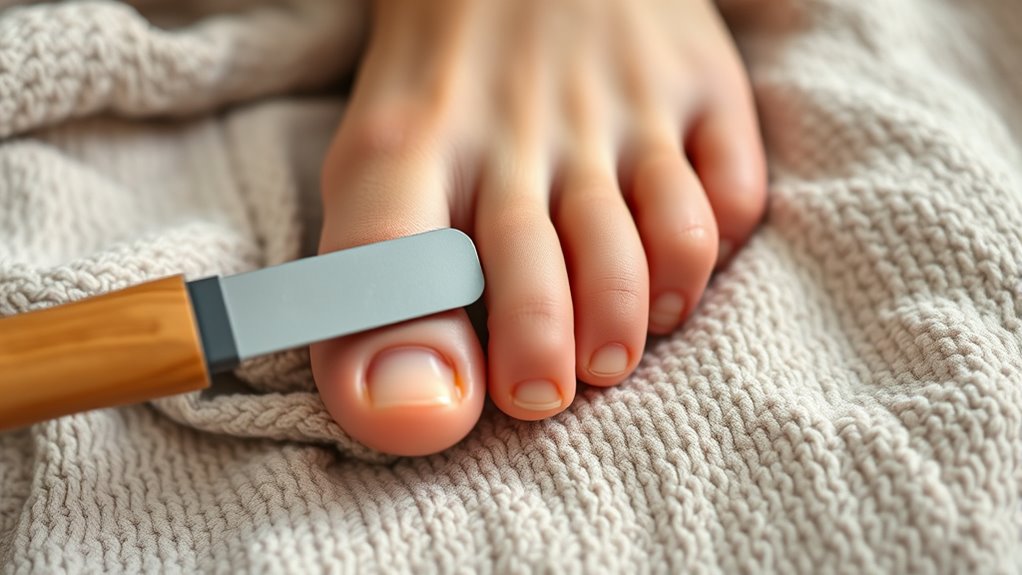To deal with thick toenails, start by soaking your foot in warm water for 10-15 minutes to soften the nail, making it easier to file. Use a coarse nail file or emery board and file in one direction to avoid damage. Be gentle to prevent pain or tears, and shape the nail to prevent catching. With consistent care and proper technique, you’ll see improvements, and more helpful tips await if you continue exploring.
Key Takeaways
- Soak your toes in warm water to soften thick nails before filing for easier shaping.
- Use a coarse nail file or emery board, filing in one direction to prevent damage.
- Gently file the nail surface to smooth rough edges without over-filing, which weakens the nail.
- Incorporate antifungal solutions during soaking if infection is suspected or to prevent fungal growth.
- Maintain regular nail trimming and filing routines to promote healthy nail growth and prevent further thickening.

Thick toenails can be uncomfortable and sometimes embarrassing, but they’re a common problem that many people face. If you’re dealing with thickened nails, you might notice that they’re harder to trim and shape properly. One of the main causes of thick toenails is nail fungus, which can lead to a brittle, discolored, and overgrown appearance. While it’s tempting to ignore the problem or just file down the thickened parts, proper care is essential to prevent further issues and keep your nails healthy.
When it comes to managing thick toenails, the first step is to understand the importance of regular toenail trimming. Using the right tools, like sharp toenail clippers or scissors designed for thick nails, makes a significant difference. Be gentle and take your time; rushing can cause pain, tears, or even injury. If the nail is too thick or hard to cut, soaking your foot in warm water for about 10-15 minutes can soften the nail, making trimming easier. Adding a bit of Epsom salt or antifungal solutions to the soak can help reduce nail fungus or prevent its spread. After soaking, dry your feet thoroughly to prevent moisture buildup, which can encourage fungal growth.
File the nail carefully after trimming, especially if it’s uneven or jagged. Use a coarse nail file or emery board to smooth out rough edges and shape the nail. Keep in mind that filing should be done gently and in one direction to avoid damaging the nail or causing pain. Regular filing also helps prevent the nail from catching on socks or shoes, which can worsen the thickening or lead to splits. Be cautious not to over-file or remove too much of the nail surface, as this can weaken the nail further. Incorporating AI-driven tools like digital monitoring or reminders can help you maintain a consistent nail care routine.
If nail fungus is suspected or confirmed, you might consider over-the-counter antifungal treatments or consult a healthcare professional for stronger medication. Addressing nail fungus early prevents further thickening and helps restore the nail’s natural appearance. Consistent care, including good foot hygiene and wearing breathable footwear, also supports healthy nail growth. Remember, thick toenails don’t usually improve overnight. Patience, combined with proper trimming, filing, and potentially antifungal treatments, can make a noticeable difference over time. Taking these steps not only improves the look of your nails but also reduces discomfort and lowers the risk of infections. Keep your toenails clean and well-maintained, and don’t hesitate to seek professional advice if the problem persists or worsens.
Frequently Asked Questions
Can Thick Toenails Be a Sign of a Serious Health Issue?
Thick toenails can sometimes signal a serious health issue, especially if accompanied by nail discoloration or toenail fungus. These symptoms might indicate fungal infections or underlying conditions like psoriasis or circulation problems. You should see a healthcare professional if your toenails become thick, discolored, or brittle. Early diagnosis and treatment can prevent complications, so don’t ignore persistent changes in your toenails.
How Often Should I File My Thick Toenails?
Filing your thick toenails is like trimming a garden’s overgrown weeds—gentle, steady, and regular. You should file them once every one to two weeks, depending on growth. Keep in mind, good foot hygiene and nail polishing can help maintain healthy nails. Avoid over-filing, which can damage your nails. Regular care prevents discomfort and keeps your feet looking neat, so stay consistent with your nail routine.
Are There Home Remedies to Soften Thick Toenails?
You might wonder if there are natural remedies for nail softening. Yes, you can try soaking your toes in warm water mixed with Epsom salt or tea tree oil, which helps loosen thick nails. Applying coconut oil or olive oil daily can also soften nails over time. These natural remedies promote nail softening, making filing easier and reducing discomfort. Consistent care is key to improving thick toenails naturally.
When Should I See a Podiatrist About Thick Toenails?
Think of your toenail like a fortress; if it’s thick, discolored, or painful, it’s time to call in a professional. You should see a podiatrist if you notice signs of toenail fungus, persistent pain, or if you have diabetes management concerns. Ignoring these signals can lead to more serious issues. Don’t wait—early treatment keeps your feet healthy and your steps confident.
Can Thick Toenails Cause Other Foot Problems?
Thick toenails can lead to other foot problems, especially if caused by nail fungus or toenail trauma. The fungus can spread, causing discomfort and infections, while trauma might weaken the nail and surrounding skin. These issues can lead to pain, difficulty walking, or even further infections. It’s essential to address thick toenails early, seek treatment, and maintain proper foot hygiene to prevent complications and keep your feet healthy.
Conclusion
Dealing with thick toenails can seem intimidating, but with proper filing and care, you can manage them effectively at home. Don’t let fear of pain or causing damage hold you back—gentle, consistent care makes a difference. Remember, if your toenails are severely thick or painful, seeing a healthcare professional is the best step. With patience and the right approach, you’ll keep your toenails healthy and comfortable without unnecessary worry.









